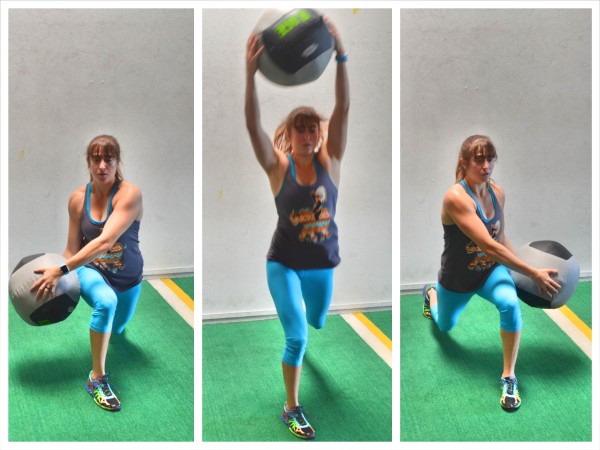
The 30/30 Med Ball Cardio Blast
WARM UP
Stretch and Roll Out:
Calves
Hamstrings
Quads
Groin
Hips/Glutes
Chest/Shoulders/Traps
WORKOUT
Perform 5-8 rounds of the circuit below. This is a quick workout. Do not take extra rest between rounds.
CIRCUIT:
30 seconds Med Ball Chest Pass and Shuffle
30 seconds Rest
30 seconds Alternating Rotational Throws
30 seconds Rest
30 seconds Squat and Throw
30 seconds Rest
30 seconds Rainbow Split Squat Jumps
30 seconds Rest
30 seconds Sit Up and Throw
30 seconds Rest
COOL DOWN
Stretch and Roll Out:
Calves
Hamstrings
Quads
Groin
Hips/Glutes
Chest/Shoulders/Traps
NOTES:
Work as hard as you can for the 30 seconds then rest for 30 seconds. Do not rest during the 30 seconds of work. Instead regress the move if needed. Move from one exercise to the next. Do not rest extra between rounds.
Beginners though may need to take 1-2 minutes between rounds and do only 3 or even 4 rounds instead of 5.
EXERCISE DESCRIPTIONS:
Med Ball Chest Pass and Shuffle – To do the Chest Pass and Shuffle, hold a med ball in both hands at your chest and face a wall. You want to be far enough from the wall that you have room to extend your arms and pass the ball; however, you want to be close enough to the wall that it will bounce back to you and that you can catch and pass quickly. Then throw the ball out from your chest into the wall and begin to shuffle laterally. To pass the ball press it straight out from your chest and extend your arms toward the wall. Drill the ball straight into the wall and then catch it and bring it back into your chest. Shuffle one direction as you pass and then change directions and shuffle back as you repeat the quick passes. Keep the shuffles one direction short. You don’t have to go 50 feet to one side and then back. Room for 3-4 shuffles each way is more than enough. Make sure to stand up nice and tall and keep your chest pressed out as you pass and shuffle. If you have a partner, you can do the Chest Pass and Shuffle together, passing the ball back and forth as you both shuffle the same way.
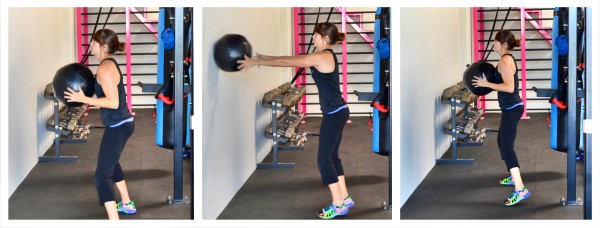
Alternating Rotational Throws – To do Alternating Rotational Throws, start in a very slightly staggered stance with your side to the wall. Holding the ball in both hands, reach the ball back toward the hip of the back foot. Then, throwing it underhanded, toss it straight against the wall as hard as possible. As you throw, bring your back foot forward and switch to face the other direction and catch the ball, bringing it back toward your other hip. Then throw the ball against the wall and switch back to the first side. Keep rotating and alternating back and forth. The harder you throw the ball and the quicker you move, the harder the move will be.

Squat and Throw – To do the Squat and Throw, hold a med ball in both hands at your chest and stand with your feet about hip-width to shoulder-width apart. You can stand facing a way to throw up at or you can simply throw up toward the ceiling. Then squat down with the ball at your chest. As you explode up out of the squat, press the ball from your chest throwing it as high up as you can. It is ok to explode out of the squat and jump as you throw the ball from your chest up as high as possible. Make sure that as you throw you extend your body and your arms up toward the ball. Then catch the ball either straight off the throw or after a bounce on the ground and sink right back into the squat and repeat. Do not round forward as you sink into the squat while holding the ball at your chest. This also doesn’t have to be a squat where you sink your butt all the way to the ground, but you do want to make sure to sit your butt back and down. Throw the ball as high as you can. Add weight if you can easily throw it super high or as high as your space allows!
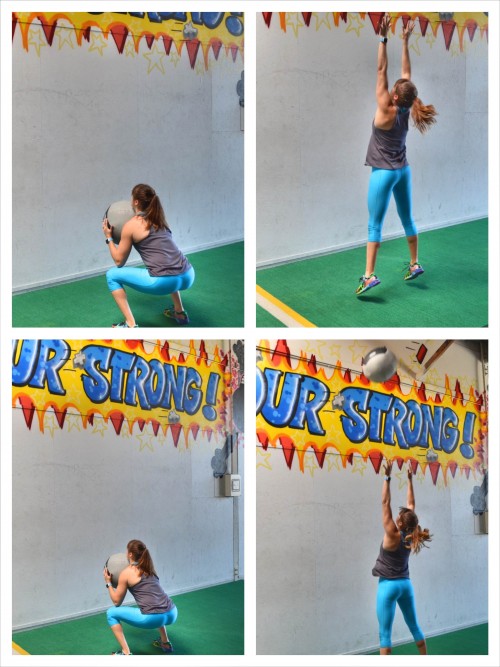
Rainbow Split Squat Jumps – To do Rainbow Split Squat Jumps, step one foot forward so you are in a nice wide stance. Hold the ball in both hands and bring it outside that front leg. Sink into a deep lunge, bending the back knee down toward the ground as you bend the front knee. Bring the ball outside your front hip. Then jump up and as you do switch your legs so that you land with the opposite leg in front. As you jump and switch legs, swing the ball up overhead and down outside the other hip. When you land and bring the ball outside your other hip, sink straight into a lunge on the other side. Then jump back into a lunge on the first side, swinging the ball in a rainbow overhead and down to the other hip. Move quickly and try to get up off the ground. Get as deep in the lunges as you can as well. Make sure though that you don’t start to go forward, but land and sit back in the lunge a bit. Beginners may not be able to sink as low in the lunge and may need to do more of a step back with a hop instead of a jump from lunge to lunge.

Sit Up and Throw – To do the Sit Up and Throw, sit on the ground with your legs out in front of you. Sit far enough from the wall or your partner that you won’t either bash yourself in the face, or your partner in the face, with the ball. Holding the ball in both hands, lie back on the ground and extend the ball overhead on the ground behind you. Then sit up and as you do perform an overhead throw, throwing the ball into the wall or to your partner. Do not sit up then throw. Throw as you sit up. And sit all the way up as you follow through with the throw. Then as you catch the ball, lie back down, extending the ball back overhead. Try to move quickly, catching, lying back down, and then quickly sitting back up as you throw. Beginners may need to stick with a seated overhead throw instead of including the full sit up.
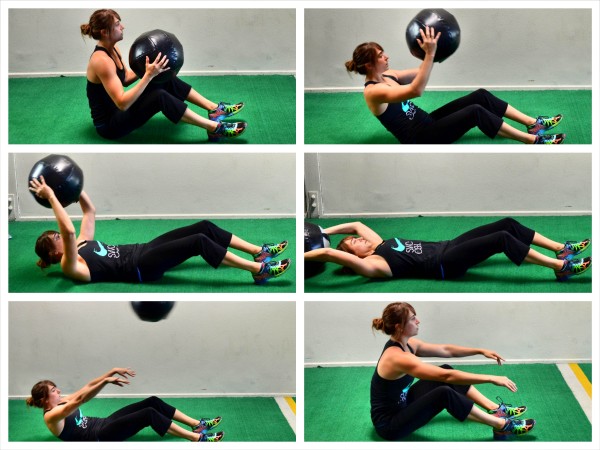

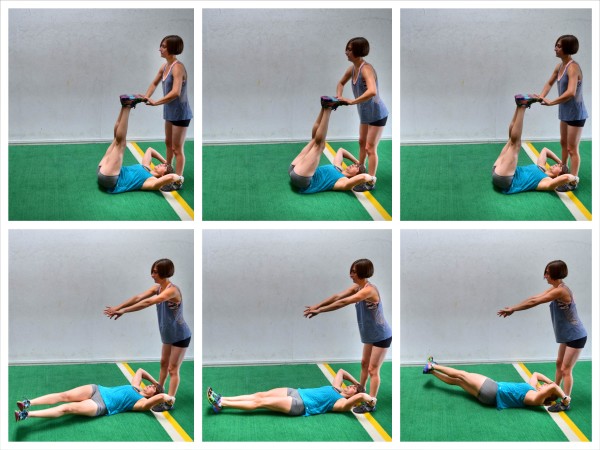
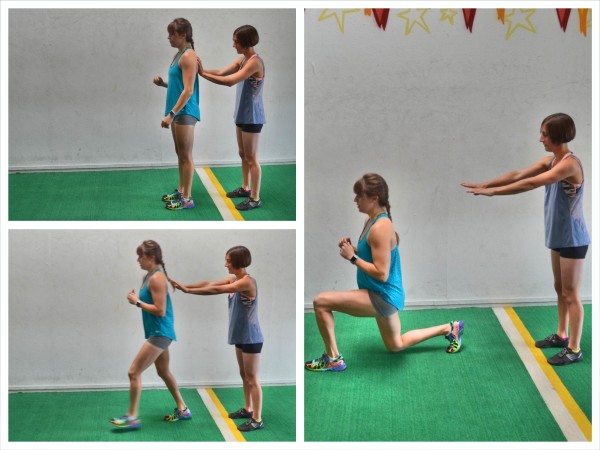
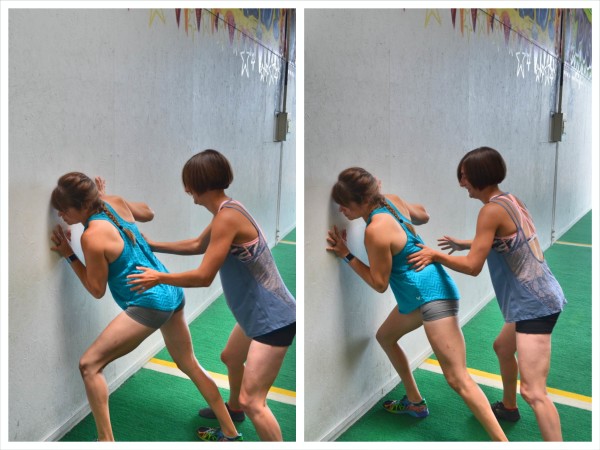

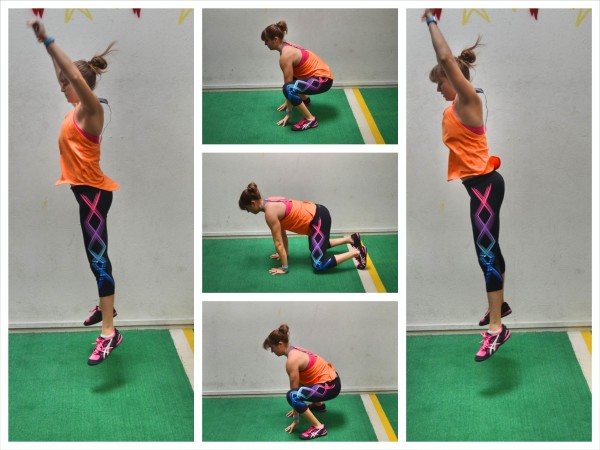
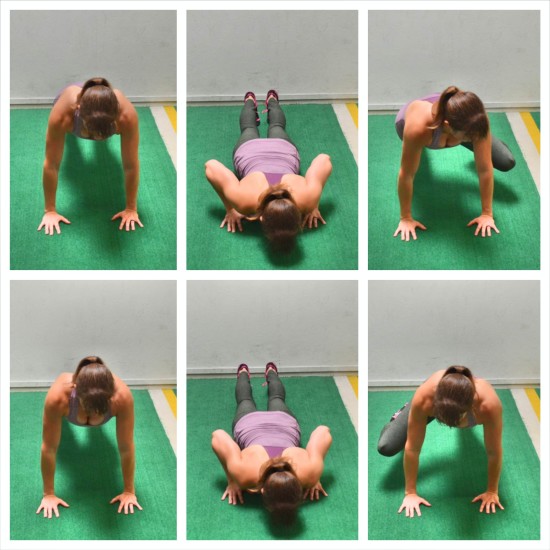
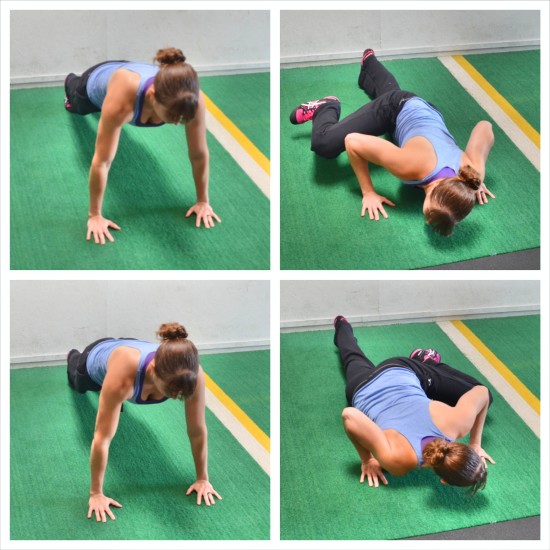

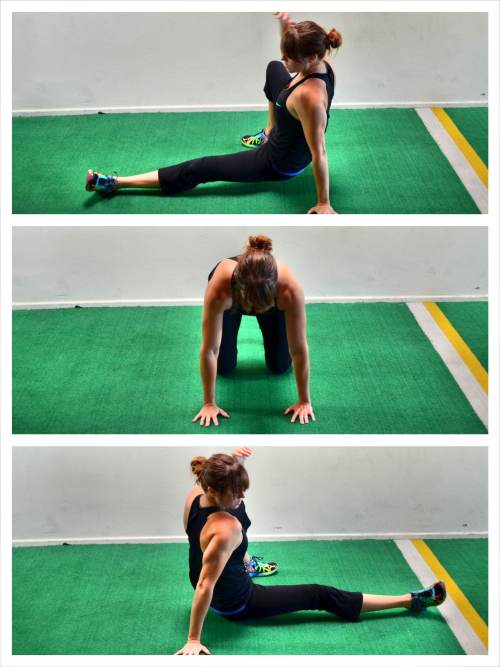
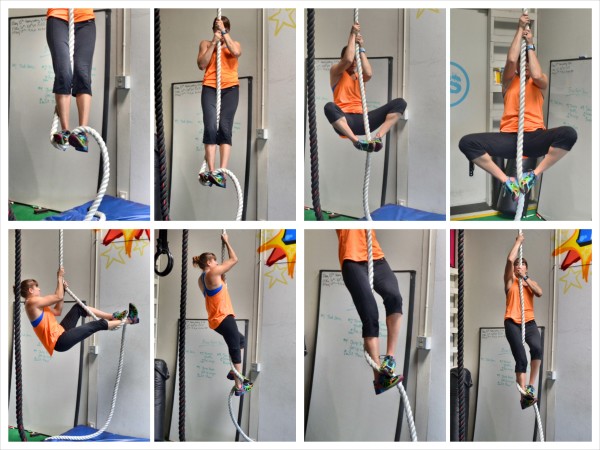
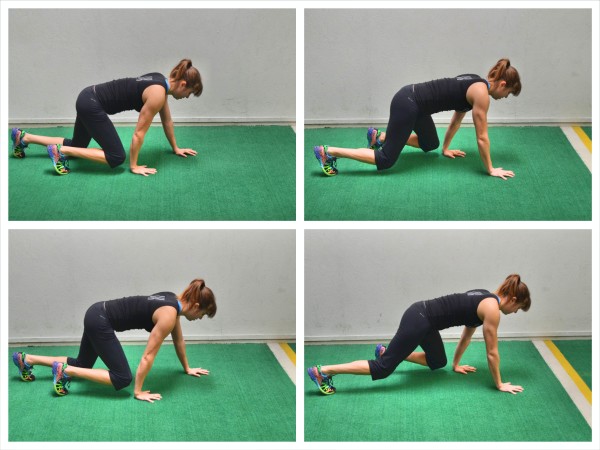 Hop Over – To do the Hop Over, you need a box, bench, punching bag or any other object you can place your hands on and jump over. Stand to one side of the bag or bench with your feet together. Place your hands down on the bag, and putting weight on your hands, jump your feet over the bag to the other side. Keep your feet together as you jump. As soon as you land, jump your feet back over the bag. Continue to do quick hops back and forth over the bag using the support of your hands. Move as quickly as possible, hopping back and forth. Beginners may need to jump one foot over at a time or even have their hands up on something, but not actually jump over anything so that they don’t have to jump more than an inch or two off the ground.
Hop Over – To do the Hop Over, you need a box, bench, punching bag or any other object you can place your hands on and jump over. Stand to one side of the bag or bench with your feet together. Place your hands down on the bag, and putting weight on your hands, jump your feet over the bag to the other side. Keep your feet together as you jump. As soon as you land, jump your feet back over the bag. Continue to do quick hops back and forth over the bag using the support of your hands. Move as quickly as possible, hopping back and forth. Beginners may need to jump one foot over at a time or even have their hands up on something, but not actually jump over anything so that they don’t have to jump more than an inch or two off the ground. 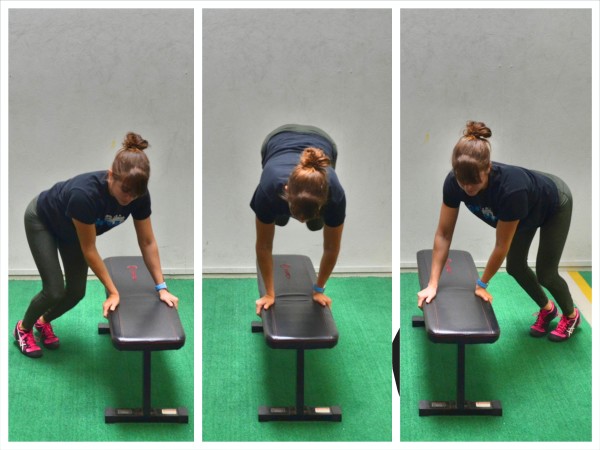 Agility Ladder – Here are
Agility Ladder – Here are 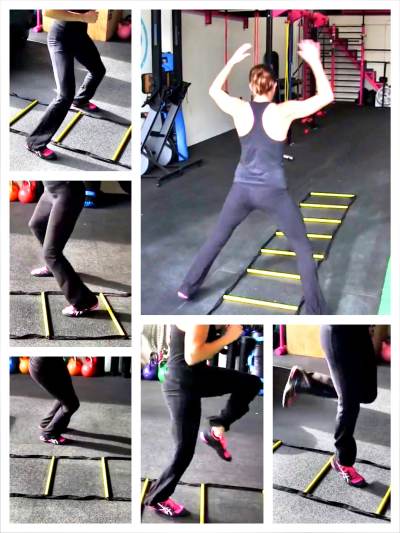 Sit Thrus – To do the Sit Thru, start on your hands and knees with your hands under your shoulders and your knees under your hips. Flex your feet and press up onto your hands and toes. Rotate open toward the right and kick your left leg under and through toward where your right hand is. As you bring your left leg forward and through, lift your right hand. You want to rotate all the way through with your left leg out straight so that you are almost sitting with your left hand down to support you. You want to “sit through.” Then bring the left leg back through so you are back in the starting position. Next rotate to the left and kick your right leg through and forward as you lift your left hand. Move as quickly as you can back and forth. Beginners may need to move slowly or even start in a more spread out position with their legs out straight instead of their knees under their hips.
Sit Thrus – To do the Sit Thru, start on your hands and knees with your hands under your shoulders and your knees under your hips. Flex your feet and press up onto your hands and toes. Rotate open toward the right and kick your left leg under and through toward where your right hand is. As you bring your left leg forward and through, lift your right hand. You want to rotate all the way through with your left leg out straight so that you are almost sitting with your left hand down to support you. You want to “sit through.” Then bring the left leg back through so you are back in the starting position. Next rotate to the left and kick your right leg through and forward as you lift your left hand. Move as quickly as you can back and forth. Beginners may need to move slowly or even start in a more spread out position with their legs out straight instead of their knees under their hips.  Monkey Bars – You can play around with any of these
Monkey Bars – You can play around with any of these  Explosive Step Ups – To do Explosive Step Ups, pick a step, chair or park bench that you can explode up off of that isn’t too high. Beginners should use a lower box while advanced exercisers will want to use a higher box but something they can still easily perform a Step Up on. To start, place one foot on top of the box (or whatever you are using). Driving up off the foot on top of the box, jump up in the air off the box. In the air, switch and land with the other foot on top of the box. Touch the other foot to the ground and then explode back up, pushing mainly off the foot on the box. Jump up as high as possible, driving off the foot on the box to switch and land with the other leg on top of the box. Keep alternating until all reps are complete. Don’t jump to simply tap your toe on the box. Your weight shouldn’t be back so you can tap your feet on the box. Truly explode up off the box. Use your arms to help propel you up as you jump. When you land swing your arms back and as you jump swing your arms up overhead.
Explosive Step Ups – To do Explosive Step Ups, pick a step, chair or park bench that you can explode up off of that isn’t too high. Beginners should use a lower box while advanced exercisers will want to use a higher box but something they can still easily perform a Step Up on. To start, place one foot on top of the box (or whatever you are using). Driving up off the foot on top of the box, jump up in the air off the box. In the air, switch and land with the other foot on top of the box. Touch the other foot to the ground and then explode back up, pushing mainly off the foot on the box. Jump up as high as possible, driving off the foot on the box to switch and land with the other leg on top of the box. Keep alternating until all reps are complete. Don’t jump to simply tap your toe on the box. Your weight shouldn’t be back so you can tap your feet on the box. Truly explode up off the box. Use your arms to help propel you up as you jump. When you land swing your arms back and as you jump swing your arms up overhead. 


